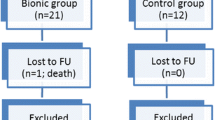Abstract
Due to its hollow construction, which gives it elasticity, the Cenos hollow stem (Artos) reduces stress shielding in the intertrochanteric region and reduces bone remodelling at the distal tip after implantation of a cementless stem in the femoral canal. This should contribute to a longer implant survival time and reduce the number of revision procedures required for implant loosening. Its anatomical shape means that it fits well in the femoral canal and additionally improves load distribution. We prospectively studied patients in whom the Cenos hollow stem was implanted in our clinic. The clinical results after 1 year and 40 implantations are very satisfactory. No thigh pain has been reported so far, which is probably due to the effectiveness of the increased elasticity and the better fit of the stem. Preoperative planning with a special template is very accurate, and in combination with the anatomical shape of the stem makes the surgical procedure easy. The relatively high number of ectopic ossifications found in our series is obviously not related to the stem itself. In our opinion it is a result of the lateral approach. However, no clinical disadvantage resulted from these ossifications.
Similar content being viewed by others
References
Bobyn JD, Goto H, Krygier JJ, Glassman AH, Brooks CE, Miller JE (1990) The effect of stem stiffness on femoral bone resorption after canine porous coated hip replacement. 36th Annual Meeting, Orthopaedic Research Society, New Orleans, Louisiana
Brooker AF, Bowerman JW, Robinson RA, Riley LH (1973) Ectopic ossification following total hip replacement. J Bone Joint Surg [Am] 55-A:1629–1632
Cameron HU, Trick L, Shepard B, Turnbull A, Noiles D, McTighe T (1990) An international multi-center study on thigh pain in total hip replacement. American Academy of Orthopaedic Surgeons Meeting, New Orleans, Louisiana
Engh CA, Bobyn JD (1988) The influence of stem size and extent of porous coating on femoral bone resorption after primary cementless hip arthroplasty. Clin Orthop Rel Res 231:7–28
Harris WH (1969) Traumatic arthritis of the hip after dislocation and acetabular fractures: treatment by mold arthroplasty. J Bone Joint Surg [Am] 51-A:737–755
Heimke G, Stock D (1986) Zur Frage postoperativer Schmerzen bei zementfreien Hüftschaftprothesen. Z Orthop 124:643–645
Jantsch S, Hackl H, Leixnering M, Schwägerl W (1990) Intraoperative Schaftfissuren — eine mögliche Ursache für postoperative Schaftschmerzen nach zementfreier Hüftgelenksimplantation. Z Orthop 128:144–148
Johnston RC, Fitzgerald RH, Harris WH, Poss R, Mü1ler ME, Sledge CB (1990) Clinical and radiographic evaluation of total hip replacement. J Bone Joint Surg [Am] 72-A:161–168
Kranz C (1988) Beitrag zur Entwicklung eines elastisch angepaßten Hüftendoprothesenschaftes. In: Boenick U (ed) Biomedizinische Technik. Forschungsberichte für die Praxis, vol 2. Schiele & Schön, Berlin
Maistrelli GL, Fornasier V, Binnington A, McKenzie K, Sessa V, Harrigton I (1991) Effect of stem modulus in a total hip arthroplasty model. J Bone Joint Surg [Br] 73-B:43–46
Mattheck C, Vorberg U, Kranz C (1990) Die Auswirkungen der Hohlschaftendoprothese auf die Spannungsverteilung in der Kortikalis. Biomed Technik 35:316–319
Schmidt J, Hackenbroch MH (1993) Röntgengeführte Implantatvermessung im Femurschaft: Methodik, Leistungsfähigkeit und Konsequenzen für die CENOS-Hohlschaftprothese. 15th Munich Symposium on Experimental Orthopedics, Munich
Author information
Authors and Affiliations
Rights and permissions
About this article
Cite this article
Schmidt, J., Hackenbroch, M.H. The Cenos hollow stem in total hip arthroplasty: first experiences in a prospective study. Arch Orthop Trauma Surg 113, 117–120 (1994). https://doi.org/10.1007/BF00441616
Received:
Issue Date:
DOI: https://doi.org/10.1007/BF00441616




